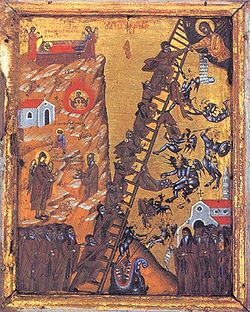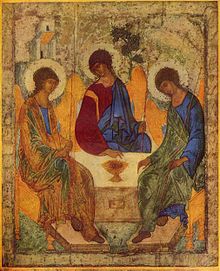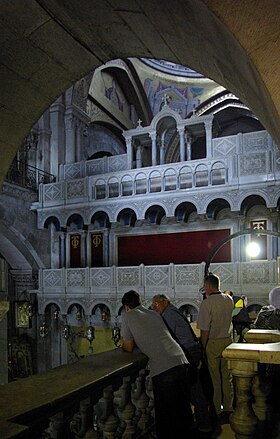In Eastern Orthodoxy deification (theosis) is a transformative process whose goal is likeness to or union with God. As a process of transformation, theosis is brought about by the effects of katharsis (purification of mind and body) and theoria. According to Eastern Orthodox teaching, theosis is very much the purpose of human life. It is considered achievable only through a synergy (or cooperation) between human activity and God's uncreated energies (or operations).
According to Metropolitan Hierotheos Vlachos, the primacy of theosis in Orthodox theology is directly related to the fact that Orthodox theology (as historically conceived by its principal exponents) is based to a greater extent than Western Catholic Latin theology on the direct spiritual insights of the saints or mystics of the church rather than the apparently more rational thought tradition of the West. Eastern Orthodox consider that "no one who does not follow the path of union with God can be a theologian".
Theology in Eastern Orthodoxy is not treated as an academic pursuit. Instead it is based on revelation (see gnosiology), meaning that Orthodox theology and its theologians are validated by ascetic pursuits rather than academic degrees (i.e. scholasticism).
Divinization

St. Athanasius of Alexandria wrote, "He was incarnate that we might be made god" (Î'á½Ï„ὸς Î³á½°Ï á¼Î½Î·Î½Î¸Ïώπησεν, ἵνα ἡμεῖς θεοποιηθῶμεν). His statement is an apt description of the doctrine. What would otherwise seem absurdâ€"that fallen, sinful man may become holy as God is holyâ€"has been made possible through Jesus Christ, who is God incarnate. Naturally, the crucial Christian assertion, that God is One, sets an absolute limit on the meaning of theosis: as it is not possible for any created being to become God ontologically, or even a necessary part of God (of the three existences of God called hypostases), so a created being cannot become Jesus Christ, the Holy Spirit nor the Father of the Trinity.
Most specifically creatures, i.e. created beings, cannot become God in His transcendent essence, or ousia, hyper-being (see apophaticism). Such a concept would be the henosis, or absorption and fusion into God of Greek pagan philosophy. However, every being and reality itself is considered as composed of the immanent energy, or Energeia, of God. As energy is the actuality of God, i.e. His immanence, from God's being, it is also the Energeia or activity of God. Thus the doctrine avoids pantheism while partially accepting Neoplatonism's terms and general concepts, but not its substance (see Plotinus).
St. Maximus the Confessor wrote: "A sure warrant for looking forward with hope to deification of human nature is provided by the Incarnation of God, which makes man God to the same degree as God Himself became man ... . Let us become the image of the one whole God, bearing nothing earthly in ourselves, so that we may consort with God and become gods, receiving from God our existence as gods. For it is clear that He Who became man without sin (cf. Heb. 4:15) will divinize human nature without changing it into the Divine Nature, and will raise it up for His Own sake to the same degree as He lowered Himself for man's sake. This is what St[.] Paul teaches mystically when he says, '[]that in the ages to come he might display the overflowing richness of His grace' (Eph. 2:7)"
Theoria

Through theoria, the contemplation of the Triune God, human beings come to know and experience what it means to be fully human, i.e., the created image of God; through their communion with Jesus Christ, God shares Himself with the human race, in order to conform them to all that He is in knowledge, righteousness, and holiness. As God became human, in all ways except sin, He will also make humans "God", i.e., "holy" or "saintly", in all ways except His Divine Essence, which is uncaused and uncreated. St. Irenaeus explained this doctrine in the work Against Heresies, Book 5, Preface: "the Word of God, our Lord Jesus Christ, Who did, through His transcendent love, become what we are, that He might bring us to be even what He is Himself."
As a Patristic and historical teaching
For many Church Fathers, theosis goes beyond simply restoring people to their state before the Fall of Adam and Eve, teaching that because Christ united the human and divine natures in Jesus' person, it is now possible for someone to experience closer fellowship with God than Adam and Eve initially experienced in the Garden of Eden, and that people can become more like God than Adam and Eve were at that time. Some Orthodox theologians go so far as to say that Jesus would have become incarnate for this reason alone, even if Adam and Eve had never sinned.
All of humanity is fully restored to the full potential of humanity because the Son of God took to himself a human nature to be born of a woman, and takes to himself also the sufferings due to sin (yet is not himself sinful, and is God unchanged in being). In Christ the two natures of God and human are not two persons but one; thus a union is effected in Christ between all of humanity in principle and God. So the holy God and sinful humanity are reconciled in principle in the one sinless man, Jesus Christ. (See Jesus' prayer as recorded in John 17.)
This reconciliation is made actual through the struggle to conform to the image of Christ. Without the struggle, the praxis, there is no real faith; faith leads to action, without which it is dead. One must unite will, thought, and action to God's will, his thoughts, and his actions. A person must fashion his life to be a mirror, a true likeness of God. More than that, since God and humanity are more than a similarity in Christ but rather a true union, Christians' lives are more than mere imitation and are rather a union with the life of God himself: so that the one who is working out salvation is united with God working within the penitent both to will and to do that which pleases God.
Stages
Theosis has three stages: first, the purgative way, purification, or katharsis; second, illumination, the illuminative way, the vision of God, or theoria; and third, sainthood, the unitive way, or theosis. Thus the term "theosis" describes the whole process and its objective. By means of purification a person comes to theoria and then to theosis. Theosis is the participation of the person in the life of God. According to this doctrine, the holy life of God, given in Jesus Christ to the believer through the Holy Spirit, is expressed through the three stages of theosis, beginning in the struggles of this life, increasing in the experience of knowledge of God, and consummated in the resurrection of the believer, when the victory of God over fear, sin, and death, accomplished in the Crucifixion and Resurrection of Jesus Christ, is made manifest in the believer forever.
"Like minded" as a form of unity

Yet through faith we can attain phronema, an understanding of the faith of the Church. A common analogy for theosis, given by the Greek fathers, is that of a metal which is put into the fire. The metal obtains all the properties of the fire (heat, light), while its essence remains that of a metal. Using the head-body analogy from St Paul, every man in whom Christ lives partakes of the glory of Christ. As St John Chrysostom observes, "where the head is, the body is also; for by no means is the head separated from the body; for if it were indeed separated, there would not be a body and there would not be a head".
Ascetic practice
The journey toward theosis includes many forms of praxis. The most obvious form being monasticism and clergy. Of the monastic tradition the practice of hesychasm is most important as a way to establish a direct relationship with God. Living in the community of the church and partaking regularly of the sacraments, and especially the Eucharist, is taken for granted. Also important is cultivating "prayer of the heart", and prayer that never ceases, as Paul exhorts the Thessalonians (1 and 2). This unceasing prayer of the heart is a dominant theme in the writings of the Fathers, especially in those collected in the Philokalia. It is considered that no one can reach theosis without an impeccable Christian living, crowned by faithful, warm, and, ultimately, silent, continuous Prayer of the Heart.
The "doer" in deification is the Holy Spirit, with whom the human being joins his will to receive this transforming grace by praxis and prayer, and as Gregory Palamas teaches, the Christian mystics are deified as they become filled with the Light of Tabor of the Holy Spirit in the degree that they make themselves open to it by asceticism (divinization being not a one-sided act of God, but a loving cooperation between God and the advanced Christian, which Palamas considers a synergy).
This synergeia or co-operation between God and Man does not lead to mankind being absorbed into the God as was taught in earlier pagan forms of deification like henosis. Rather it expresses unity, in the complementary nature between the created and the creator. Acquisition of the Holy Spirit is key as the acquisition of the spirit leads to self-realization.
Western attitudes
Western attitudes towards theosis have traditionally been negative. In his article, Bloor highlights various Western theologians who have contributed to what he calls a "stigma" towards theosis. Yet, recent theological discourse has seen a reversal of this, with Bloor drawing upon Western theologians from an array of traditions, whom, he claims, embrace theosis/deification.
The practice of ascetic prayer called Hesychasm in the Eastern Orthodox Church is centered on the enlightenment or deification, theosis of man.
Hesychasm is directed to a goal that is not limited to natural life alone and goes beyond this to deification (theosis).
In the past, Roman Catholic theologians generally expressed a negative view of Hesychasm. The doctrine of Gregory Palamas won almost no following in the West, and the distrustful attitude of Barlaam in its regard prevailed among Western theologians, surviving into the early 20th century, as shown in Adrian Fortescue's article on hesychasm in the 1910 Catholic Encyclopedia. Fortescue translated the Greek words ἥσυχος and ἡσυχαστής as "quiet" and "quietist".
In the same period, Edward Pace's article on quietism indicated that, while in the strictest sense quietism is a 17th-century doctrine proposed by Miguel de Molinos, the term is also used more broadly to cover both Indian religions and what Edward Pace called "the vagaries of Hesychasm", thus betraying the same prejudices as Fortescue with regard to hesychasm and, again in the same period, Siméon Vailhé described some aspects of the teaching of Palamas as "monstrous errors", "heresies" and "a resurrection of polytheism", and called the hesychast method for arriving at perfect contemplation "no more than a crude form of auto-suggestion"
Different concepts of "natural contemplation" existed in the East and in the medieval West.
The twentieth century saw a remarkable change in the attitude of Roman Catholic theologians to Palamas, a "rehabilitation" of him that has led to increasing parts of the Western Church considering him a saint, even if uncanonized. Some Western scholars maintain that there is no conflict between Palamas's teaching and Roman Catholic thought. According to G. Philips, the essence-energies distinction is "a typical example of a perfectly admissible theological pluralism" that is compatible with the Roman Catholic magisterium. Jeffrey D. Finch claims that "the future of East-West rapprochement appears to be overcoming the modern polemics of neo-scholasticism and neo-Palamism". Some Western theologians have incorporated the theology of Palamas into their own thinking.
Pope John Paul II said Catholics should be familiar with "the venerable and ancient tradition of the Eastern Churches", so as to be nourished by it. Among the treasures of that tradition he mentioned in particular "the teaching of the Cappadocian Fathers on divinization (which) passed into the tradition of all the Eastern Churches and is part of their common heritage. This can be summarized in the thought already expressed by Saint Irenaeus at the end of the second century: God passed into man so that man might pass over to God. This theology of divinization remains one of the achievements particularly dear to Eastern Christian thought."
See also
.jpeg/200px-Transfiguration_by_Feofan_Grek_from_Spaso-Preobrazhensky_Cathedral_in_Pereslavl-Zalessky_(15th_c,_Tretyakov_gallery).jpeg)
References
Notes
Citations
Bibliography

- Anstall, Kharalambos (2007). "Juridical Justification Theology and a Statement of the Orthodox Teaching," Stricken by God? Nonviolent Identification and the Victory of Christ". Grand Rapids, MI: Eerdmans.Â
- George, Archimandrite (2006). Theosis: The True Purpose of Human Life (PDF) (4th ed.). Mount Athos, Greece: Holy Monastery of St. Gregorios. ISBNÂ 960-7553-26-8. Retrieved 8 May 2014.Â
- Lossky, Vladimir (1997). The Mystical Theology of the Eastern Church. St. Vladimir's Seminary Press. ISBNÂ 978-0-913836-31-6.Â
- Gross, Jules (2003). The Divinization of the Christian According to the Greek Fathers. A & C Press. ISBNÂ 978-0-7363-1600-2.Â
Further reading
- Bloor, J. D. A. (2015), "New Directions in Western Soteriology", Theology 118 (3): 179â€"187, doi:10.1177/0040571X14564932Â
- Mantzardis, Georgios. The Deification of Man. St Vladimir's Seminary Press, 1997.
- Nellas, Panayiotis. Deification in Christ: The Nature of the Human Person. St Vladimir's Seminary Press, 1987.
- Finlan, Stephen ed. and Vladimir Kharlamov ed. Theosis: Deification in Christian Theology, Volume 1. Wipf & Stock Publishers, 2006.
- Kharlamov, Vladimir. Theosis: Deification in Christian Theology, Volume 2. Wipf & Stock Publishers, 2006.
- Christensen, Michael J. ed. and Jeffery A. Wittung ed. Partakers of the Divine Nature: The History and Development of Deification in the Christian Tradition. Baker Academic, 2008.
- Russell, Norman. The Doctrine of Deification in the Greek Patristic Tradition. USA: Oxford University Press, 2006.
- Keating, Daniel. Deification and Grace. Sapientia Press 2007.
- Pelikan, Jaraslov. The Christian Tradition: A History of the Development of Doctrine, Vol. 2: The Spirit of Eastern Christendom. University Of Chicago Press, 1977.
- Braaten, Carl E. ed. and Robert W. Jenson ed. Union with Christ: The New Finnish Interpretation of Luther. Wm. B. Eerdmans Publishing, 1998.
- Karkkainen, Veli-Matti. One with God: Salvation as Deification and Justification. Liturgical Press, 2005.
- Meconi, David Vincent. The One Christ: St. Augustine's Theology of Deification. The Catholic University of America Press, 2013.
External links
- Theosis_in_the_Christian_West Orthodoxwiki article
- Deification â€" online issue of Affirmation & Critique devoted entirely to the topic of theosis (Affirmation & Critique, Vol. 7 no. 2, October 2002)
- "...that we might be made God" by Kerry S. Robichaux (Affirmation & Critique, Vol. 1 no. 3, July 1996)
- Deification in Contemporary Theology by Roger Olson (Theology Today, July 2007 Vol. 64 no. 2)
- Luther and Theosis by Kurt E. Marquart (Concordia Theological Quarterly, July 2000)
- Justification as Declaration and Deification by Bruce D. Marshall (International Journal of Systematic Theology 4, no. 1)
- Shine As the Sun: C.S. Lewis and the Doctrine of Deification by Chris Jensen
- Partakers of God by Panayiotis Christou
- Partakers of the Divine Nature by Norman Russell
- Keeping the End in View by James R. Payton Jr.
- Partakers of Divinity: The Orthodox Doctrine of Theosis by Daniel B. Clendenin (Journal of the Evangelical Theological Society, September 1994)
- The Greatest Possible Blessing: Calvin and Deification by Carl Mosser (Scottish Journal of Theology)
- Some themes in Christian Mysticism by John Zuck
